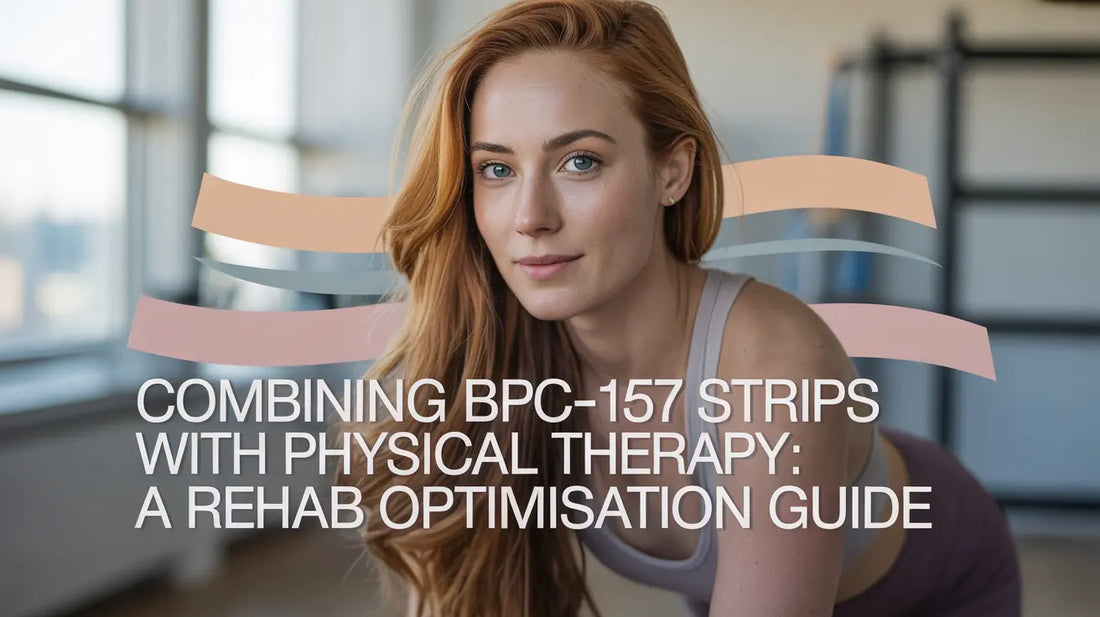
Combining BPC-157 Strips with Physical Therapy: A Rehab Optimisation Guide
Share
Use BPC-157 oral strips alongside physical therapy to accelerate healing, reduce inflammation, and maximise functional recovery.
In this guide, you’ll learn:
- Why BPC-157 strips complement PT protocols
- How to integrate strips into rehab sessions
- Optimal timing for dosing around exercise
- Key exercises that work synergistically
- Pro tips for safety and efficacy
Strips + PT
Pairing BPC-157 strips with physical therapy enhances tissue repair, pain relief, and mobility gains, taking your rehab to the next level.
- Accelerates healing: Strips promote angiogenesis and collagen synthesis, speeding up muscle, tendon, and ligament repair by delivering peptides directly to injury sites.
- Reduces inflammation: Localised anti-inflammatory effects minimise swelling and pain, allowing smoother and more effective PT movements.
- Enhances flexibility & range of motion: Improved soft-tissue quality and reduced stiffness magnify the benefits of stretching and mobility exercises.
- Boosts compliance: Easy, discreet dosing fits seamlessly into rehab routines, increasing adherence and overall treatment consistency.
- Supports endurance: Regular strip use can help sustain energy levels during prolonged therapy sessions by reducing fatigue and discomfort.
- Promotes tissue resilience: Ongoing peptide delivery fortifies extracellular matrix, making tissues more resilient against future injuries.
- Optimises neuromuscular coordination: By reducing pain, strips enable more precise muscle activation and coordination during proprioceptive drills.
- Accelerates recovery timeline: Combined with PT, strips can shorten overall rehab time, helping patients return to normal activities faster.
Why BPC-157 Strips Support Physical Therapy
Understanding the synergy between peptide action and exercise mechanics:
- Angiogenesis & blood flow: BPC-157 stimulates new vessel formation, increasing oxygen delivery during PT.
- Collagen modulation: Strips enhance collagen alignment in tendons and ligaments under mechanical load.
- Anti-catabolic effects: Protects muscle and connective tissue from overuse damage during repetitive movements.
- Neuroprotective properties: Supports nerve regeneration when combined with proprioceptive training.
Integrating Strips into Your Rehab Session
Seamlessly add strips to optimise each PT visit:
- Pre-session dosing: Apply a strip 15 minutes before exercise to prime tissues.
- During rest periods: Use a second strip if sessions exceed 60 minutes to maintain peptide levels.
- Post-session support: Take a final strip immediately after PT to sustain healing processes overnight.
Optimal Timing & Dosing
Maximise peptide and exercise synergy:
- Morning vs evening: Align dosing with the body’s circadian repair peaks, morning for mobility work, evening for deep-tissue recovery.
- Frequency: For intensive PT, consider two strips per day (pre- and post-session).
- Hydration: Maintain oral moisture to aid strip dissolution, sipping water beforehand helps.
- Pre-exercise priming: Apply a strip 15 minutes before high-intensity or resistance exercises for tissue preparedness.
- Mid-session top-up: For sessions over 90 minutes, a mid-way strip can sustain peptide levels and reduce fatigue.
- Post-exercise window: Take one strip within 10 minutes post-session to support immediate recovery pathways.
- Rest-day tapering: On non-PT days, reduce to a single evening strip to maintain baseline repair processes.
- Tracking efficacy: Log dosing times, exercise intensity, and symptom relief to fine-tune your timing protocol.
Key Physical Therapy Exercises**
Select movements that complement BPC-157’s effects:
- Isometric holds: Gentle tension without joint stress accelerates collagen reinforcement.
- Eccentric loading: Controlled lengthening supports tendon remodeling in conjunction with peptide action.
- Proprioceptive drills: Balance and coordination exercises stimulate neuroregeneration pathways.
- Range-of-motion stretches: Increase joint lubrication and peptide diffusion across tissues.
Pro Tips for Safety & Efficacy
Ensure optimal outcomes and minimise risks:
- Monitor intensity: Avoid overloading healing tissues, start low and progress under PT guidance.
- Check interactions: Wait 10 minutes between strip dosing and any other oral meds or supplements.
- Track progress: Keep a rehab log of exercises, dosing times, and symptom changes.
- Consult professionals: Always align peptide use with licensed PT and healthcare advice.
Frequently Asked Questions
Here are some questions and answers:
Can I apply strips immediately before weight-bearing exercises?
Yes, apply 15 minutes prior to allow absorption and vascular priming. Avoid immediate heavy loads in the first session to gauge tissue response.
How many strip doses are safe during a rehab week?
Most protocols use 5–7 strips per week, adjusting based on PT intensity and physician recommendations.
Will strips cause any side effects when combined with exercise?
Generally well-tolerated; rare oral tingling may occur. Ensure proper hydration and avoid dosing on irritated mucosa.
Can I switch from capsules to strips mid-rehab program?
Yes, transition to strips by matching total weekly micrograms and follow the timing guidelines above.
